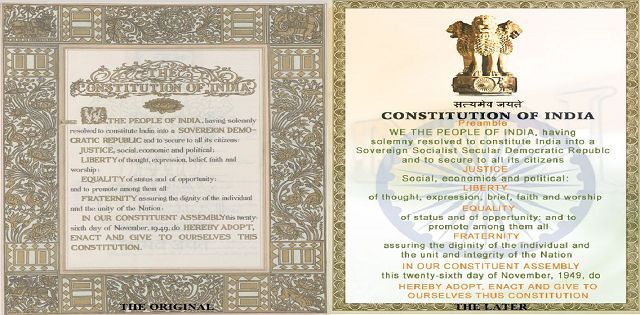The Constitution of India is the supreme law of India which frames the fundamental political principles, procedures, practices, rights, powers, and duties of the government.
The Constitution imparts the constitutional supremacy which was given by the constituent assembly, and adopted by its people, with a declaration in its preamble which even Parliament cannot override.
On November 26, 1949, the Constitution was adopted, a milestone on the country’s path to becoming an independent, sovereign republic. After coming into force on January 26, 1950, the Constitution binds all citizens of the country.India’s Constitution is the longest written constitution in the world. It took 2 years, 11 months, and 17 days to complete the Constitution.
The Constitution-makers took about two years to draft a comprehensive document that would govern the country and define the rights and duties of citizens and the State’s duty to protect citizen’s rights. As such it is the chassis atop which all law and courts in the country operate from. The Supreme Court is tasked with defending the Constitution from excessive State interference.
The Preamble of the Constitution says India is a sovereign, socialist, secular, democratic republic, assuring its citizen’s justice, equality, and liberty and endeavours to promote fraternity. The words “socialist” and “secular” were inserted into the Preamble by the Indira Gandhi government via the 42nd Amendment during the Emergency in 1976.
The Constitution delineates the fundamental political code, structure, procedures, powers, and duties of government institutions. It also explains the fundamental rights, directive principles, and the duties of citizens.
The Constitution of India provides its citizens with six fundamental rights. These are: Right to Freedom, Right to Equality, Cultural and Educational Rights, Right to Constitutional Remedies, Right against Exploitation. Recently, the Right to Privacy has also been added to the list of fundamental rights.
The original text of the Constitution had 395 articles in 22 parts and eight schedules. It came into effect on January 26, 1950, the day that India celebrates each year as the Republic Day. The number of articles has since increased due to 103 amendments.
The Constitution of India has seen a number of amendments since then but its basic objective—to preserve the concepts of parliamentary democracy, civil liberties, social and economic justice—remain to this day. Critics may differ.
India has been a successful democracy since its Constitution came into being unlike many other countries that became independent during the same time.
Bhimrao Ramji Ambedkar was appointed chairman of the drafting committee on August 28, 1947, to draft a permanent and organised constitution for India. The Constitution was drawn from a number of sources, including the Government of India Act, 1858, the Indian Councils Acts of 1861, 1892 and 1909, the Government of India Acts of 1919 and 1935, and the Indian Independence Act, 1947. The latter, which led to the creation of India and Pakistan, divided the former Constituent Assembly into two. Each new assembly had the sovereign power to draft and enact a new constitution.
An interesting fact of the Indian Constitution is that it was enacted at the time of Independence, when thus country was already facing the enormous challenges, including safeguarding the lives and welfare of millions of people who had been displaced by Partition.
During such fractious and uncertain times, the Constituent Assembly achieved a constitution reflecting the nation’s exceptional diversity in languages, races and castes.
The Constitution of India is not a collection of articles and schedules, but goes far beyond that. In addition to establishing and empowering India’s institutions of governance, it has other benefits.
In a study on the Constitution, it was found that the constitution was a transformative Constitution as it was embedded with vision for the future.
It is amazing to know that till date it has not been required to alter an article completely; instead, the law merely amends the article.
The credit for the Constitution’s drafting, belongs to Dr B.R. Ambedkar, who is also known as the Father of the Indian Constitution for this stupendous feat. He was assisted by a team of splendid minds.
The supreme law of the land does not only concern the land of India as it but also social justice and economic justice for each citizen.There is an important lesson to be learned from our Constitution-makers which is taking decisions with a lot of patience among people from diverse communities.
Every year on Constitution Day, we re-read the pledge to reaffirm our commitment to uphold and adhere to it as an integral and imperative part of the celebrations.
Jai Hind!


